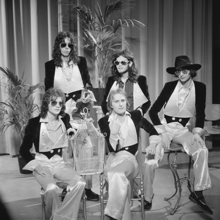Make Me Smile (Come Up and See Me)
In February 1975, the song reached number one on the UK chart and received a gold certification from the British Phonographic Industry in October 2021.
For many years, it was believed that Harley purposely chose to disband the original line-up and embark on a new career path.
[5] Between May and July 1974, Cockney Rebel embarked on a major British tour to promote their second studio album The Psychomodo.
[6] Jean-Paul Crocker, Milton Reame-James and Paul Jeffreys had approached Harley, insisting they could also write material for the group.
Harley, the band's sole songwriter, felt this was unfair as he had been the one to originally hire the musicians for his group, and explained the deal to them at the time.
In a television interview recorded in 2002, Harley described how the lyrics were vindictively directed at the former band members who, he felt, had abandoned him.
The tune was based on an unused Harley-penned track called "Laid in the Shade", which was the first song Harley ever performed when he began playing in London folk clubs on open-mike nights in 1971 and one which he demoed that same year using his classical guitar at Venus Recording Studios in Whitechapel.
[11][12] Returning to this earlier tune, he wrote new lyrics and came up with a slow blues track with a dark mood, a song vastly different from the one that was recorded.
"[10] In One Thousand UK Number One Hits by Jon Kutner and Spencer Leigh, Harley recalled the end of Cockney Rebel version 1:[4] We split up because they wanted to take my leadership away.
It was arrogant but I knew they were wrong - they didn't understand the group like I did.The new line-up of the band recorded The Best Years of Our Lives album in November–December 1974 at Abbey Road Studios in London.
On a day in November, Harley arrived at the studio and played the band the original "slow blues" version of the song for them to rehearse.
[14] Harley recalled to Uncut in 2012 that it was "a little dirgy, slower and a little pedestrian, very on the beat",[13] while guitarist Jim Cregan recounted in 2022 that the original presentation was "a bit ramshackle" and "not an obvious single".
For example I remember on Steve Harley's "Make Me Smile (Come Up And See Me)" he was phrasing the chorus completely differently and I suggested that he made it more rhythmic and I think that is part of the hook of the whole record, so I take a bit of credit for that – although I didn't get paid for it.Keyboardist Duncan Mackay came up with the ascending notes used for the song's introduction.
It was a composite of three separate takes.A number of backing singers contributed to the song, including future chart-topper Tina Charles, as well as Yvonne Keeley, Linda Lewis and Liza Strike.
"[20] In 2000, Harley re-recorded "Make Me Smile", with backing vocals by the London Community Gospel Choir, for the British film Best.
[29] "Make Me Smile (Come Up and See Me)" became Steve Harley and Cockney Rebel's biggest selling hit and has sold over 1.5 million copies worldwide as of 2015.
On 13 April 1992, EMI reissued the single on 7-inch, cassette and CD formats ahead of their Make Me Smile – The Best of Steve Harley and Cockney Rebel compilation.
[36] Following a request on Top Gear to download the song, "Make Me Smile" re-entered the UK charts at number 72 in early February 2015.
[42] The song has been used in the soundtracks of the films Rik Mayall Presents Dancing Queen (1993), The Full Monty (1997), Velvet Goldmine (1998), Best – The George Best Story (2000), Saving Grace (2000), and Blackball (2003).
The show's presenters Jeremy Clarkson, Richard Hammond and James May urged viewers to download the song in a bid to help him pay the fine.
Additionally, Harley posted a YouTube video where he performed a forty-second version of the song acoustically, with a new set of lyrics relating to the speeding fine.
[13] According to the EMI producer of the single, Tony Clark, it was Marc Bolan who made the phone call to Top of the Pops, and had Harley in the BBC studio that same evening of the recording.
[50] Sue Byrom of Record & Popswop Mirror felt the song lacked the "punch" and "innovative flash" of the original Cockney Rebel, but predicted it would be a hit.
[52] The Irvine Herald felt the song "knocks spots off their old material" and added that the guitar solo is "a delight to listen to".
[53] Jim Green of Trouser Press considered it "simple and somewhat catchy", with Harley's "excessively mannered vocal provid[ing] a nice contrast to the chick singers hooting in the background".
[54] Alan Jones, writing for Music Week in 1995, called the song a "classic contrivance" that is "forged mainly from tongue-in-cheek observation of Dylan mannerisms, though it does have a melodic strength and grace all of its own.
7-inch EP The English synth-pop duo Erasure included "Make Me Smile (Come Up and See Me)" on their cover versions album Other People's Songs.
The music video has Erasure members Vince Clarke and Andy Bell in the midst of computer-generated special effects and graphics.
